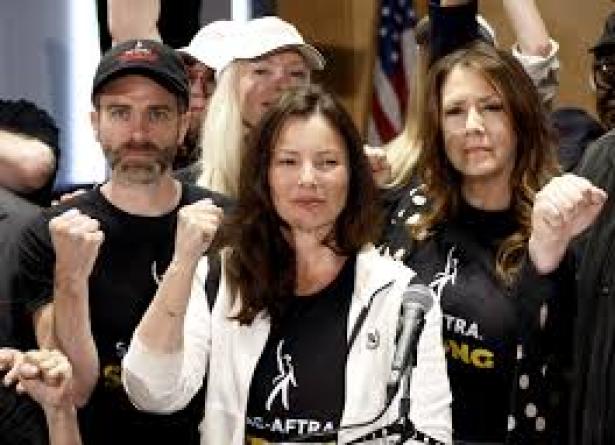Fran Drescher, Jewish union militant, forceful anti-capitalist in her own Hollywood world, even maybe a socialist. No one like her at the head of the Screen Actors Guild (now SAG-AFTRA) since Ed Asner, but with a Queens somehow-yiddish accent and body language, she brings back memories of garment union strikes more than a century ago. Other Jewish union leaders and activists are not hard to find these days, nor cultural workers unembarrassed to take on the modern-day class struggle. Collectively, they represent something bigger and more complex than the issues seemingly at hand.
These leaders and their activist cadre are, whether they know it or not, the continuity part of a deep culture, a Jewish American popular culture leaning Leftward toward a more egalitarian order. They are also part of a resistance against the other, more respectable Jewish leadership, the successful businessmen and philanthropists who dominate the institutional world. Yesterday’s tenant versus a landlord, garment worker against the sweatshop owner, even militant young woman activist against a bureaucratic and sexist union leadership, is today’s activist in labor, environment and peace. The powerful naturally curse them, a curse that passes through the generations, and the activists struggle to find their own voice across the same generations.
The struggle is often waged within popular culture, the one place along with unions where the Jewish Left has made itself felt in the US. Way back in 2007, the three volumes of essays that I had collected and edited under the title of Jews and American Popular Culture, the writings of some forty writers, enjoyed a send-off at the Center for Jewish History in Manhattan. We had a fine, generationally diverse crowd. A few rows behind me sat Richard Adler, the lyricist of “Hernando’s Hideaway” from the pro-union musical “Pajama Game.”Up on the stage, a handful of the contributors, mostly young and female, leaped at the chance to describe a generational shift. They were writing dissertations about subjects that no senior professor would likely have approved even thirty years earlier: Jewish cuisine and fashion innovators, Jewish women’s sports (there was a lot of Jewish sports: good archives had been kept in Chicago and elsewhere), nose jobs, the adult film industry, crime families and so on.
It was a pretty leftwing night in its own, definitely scholarly way, setting off my own stream of memories as oral historian and radical curiosity-seeker. The Jewish impact on basketball (known during the 1920s-30s as a sport uniquely suited to strategy, tactics and hand-eye coordination) recalled the famed CCNY coach who wrote sometimes for a Popular Front youth magazine, as any reference to Barbra Streisand brought back memories to The Way We Were. Or to the story of Joe Louis chatting days before a big fight with Lester Rodney, the sports editor of the Daily Worker (and an interviewee of mine). Or to the big Hollywood movies written by the hugely successful scriptwriters who would go on the Blacklist in 1950 (I interviewed a few of them). Or to Pete Seeger, Paul Robeson Woody Guthrie, three Gentiles who made it big in Jewish popular culture. On that particular night, I headed uptown to stay with a guy actually raised in the Borsht Belt, working in his father’s semi-kosher bodega, meeting famed former boxer Barney Ross and his pal, a former weight-lifter known in his prime as “the Mighty Atom.”
Decades ago, even the discussion of an obvious topic, “Jews and Hollywood,” raised eyebrows. Even talking about it out loud, many thought and a few oldtimers whispered to me when I lectured to old timers in the 1980s, somehow encouraged antisemitism. Well into the 1960s, Jewish film and television stars, with few exceptions, had adopted Gentile names, for mostly good reasons. Investigating committees in the same New York courtroom of the early 1950s saw (mostly) Jewish Communists and (mostly) Jewish publishers of comic books, accused of promoting the same dangers, the subversions of American society, especially of Christian youngsters among others who did now know enough to resist.
These days, with the flourishing popular culture studies, new journals and well-attended classes in such previously-improbable zones as comic art, unearth more heavily-Jewish subjects long buried away. Along with them, the old divisions of Right and Left within Jewish American life seem to be on display once more, with familiar tropes set deeply in popular culture. Movie stars at the top of their profession join leading business executives to warn against the twin dangers of antiSemitism and of Jews disloyal to Israel. And once again, as repeatedly for the generations since immigration, educated Jewish youngsters in particular seem triballly disloyal, while oldtimers, furious and vindictive, seek to hand out punishments.
Within the misunderstood world of Jewish American culture we might find some ways to look at the “Jewish Crisis” anew. Pushed aside as new immigrants and Jews, the creators of music, movies, theater, popular journalism had powerful lessons to offer, and they weren’t all about personal success followed by philanthropy. The feeling of “outsideness” offered a sense, inconsistent but real, of identification with the other outsiders. In the fears for their extended families left behind in Europe, a vivid feeling of resistance to the rise of race-based rightwing movements, and a determination to find somehow the key to another, better world order.
Paul Buhle is, most recently, coeditor of W.E.B. DuBois’s Souls of Black Folk: A Graphic Interpretation. He has been a historian of labor and of Madison, Wisconsin’s political traditions. He recently left Madison to return to Providence, Rhode Island.
Thanks to the author for submitting this to Portside.


Spread the word